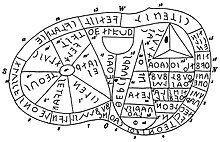User:Chartreusetuningkey/Haruspex
NOTE: I'm completely rewriting the "Haruspicy in Ancient Italy" section.
Haruspicy in Ancient Italy[edit]

Roman haruspicy was a form of communicating with their gods. Rather than strictly predicting future events, this form of Roman divination allowed humans to discern the attitudes of the gods and react in a way that would maintain harmony between the human and divine worlds (pax deorum).[1] Before taking important actions, especially in battle, Romans conducted animal sacrifices to discover the will of the gods according to the information gathered through reading the animals' entrails.[1] The entrails (most importantly the liver, but also the lungs and heart) contained a large number of signs that indicated the gods' approval or disapproval. These signs could be interpreted according to the appearance of the organs, for example, if the liver was "smooth, shiny and full" or "rough and shrunken."[2]

Haruspicy in Ancient Italy originated with the Etruscans. Textual evidence for Etruscan divination comes from an Etruscan inscription: the priest Laris Pulenas' (250-200 BCE) epitaph mentions a book he wrote on haruspicy. A collection of sacred texts called the Etrusca disciplina, written in Etruscan, were essentially guides on different forms of divination, including haruspicy and augury.[3] In addition, a number of archeological artifacts depict Etruscan haruspicy. These include a bronze mirror with an image of a haruspex dressed in Etruscan priest's clothing, holding a liver while a crowd gathers near him. Another significant artifact relating to haruspicy in Ancient Italy is the Piacenza Liver. This bronze model of a sheep's liver was found on accident by a farmer in 1877. Names of gods are etched into the surface and organized into different sections.[3] Artifacts depicting haruspicy exist from the ancient Roman world as well, such as stone relief carvings located in Trajan's Forum.[2]
- ^ a b Johnston, Sarah Iles. "Divination: Greek and Roman Divination." In Encyclopedia of Religion, 2nd ed., edited by Lindsay Jones, 2375-2378. Vol. 4. Detroit, MI: Macmillan Reference USA, 2005. Gale eBooks.
- ^ a b Driediger-Murphy, Lindsay G, and Eidinow, Esther. Ancient Divination and Experience. Oxford: Oxford University Press USA - OSO, 2019.
- ^ a b MacIntosh Turfa, Jean, and Tambe, Ashwini, eds. The Etruscan World. London: Taylor & Francis Group, 2013. ProQuest Ebook Central.
